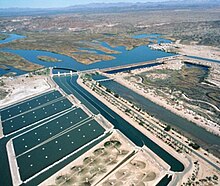
Back Azute AN Assut Catalan Abschlagsbauwerk German Azudo Esperanto Presa derivadora Spanish Desbideratze-presa Basque سد انحرافی Persian


A diversion dam is a dam that diverts all or a portion of the flow of a river from its natural course. Diversion dams do not generally impound water in a reservoir; instead, the water is diverted into an artificial water course or canal, which may be used for irrigation or return to the river after passing through hydroelectric generators, flow into a different river or be itself dammed forming an onground or groundwater reservoir or a storm drain.
An early diversion dam is the Ancient Egyptian Sadd el-Kafara Dam at Wadi Al-Garawi, which was located about twenty five kilometres south of Cairo. Built around 2600 BC for flood control, the structure was 102 metres long at its base and 87 metres wide. It was destroyed by a flood while it was still under construction.[1][2]
- ^ Günther Garbrecht: "Wasserspeicher (Talsperren) in der Antike", Antike Welt, 2nd special edition: Antiker Wasserbau (1986), pp.51-64 (52f.)
- ^ Mohamed Bazza (28–30 October 2006). "Overview of the History of Water Resources and Irrigation Management in the Near East Region" (PDF). Food and Agriculture Organization of the United Nations. Archived from the original (PDF) on 2007-08-08. Retrieved 2007-08-01.